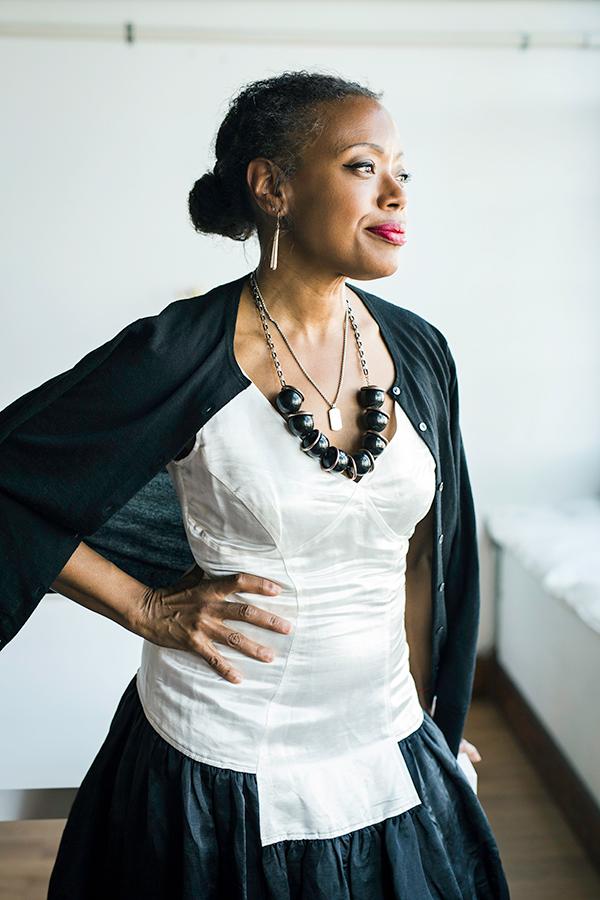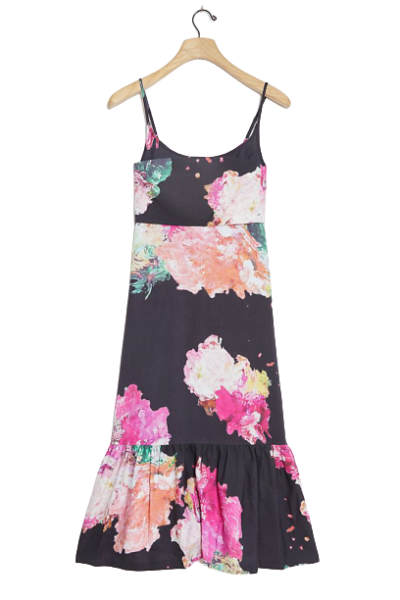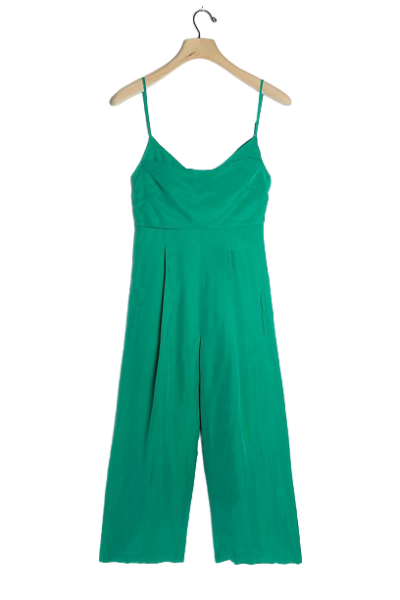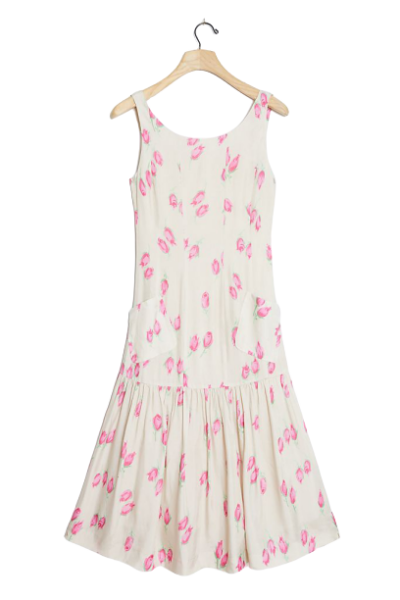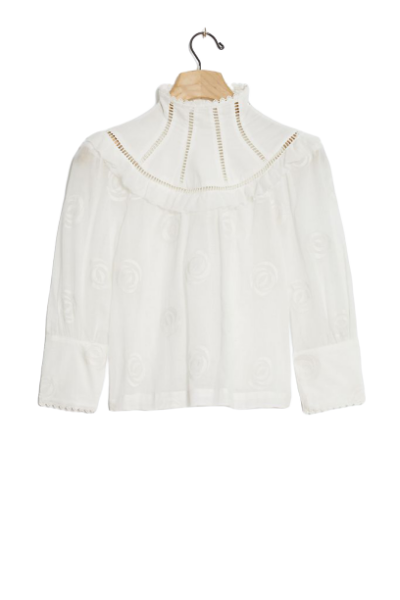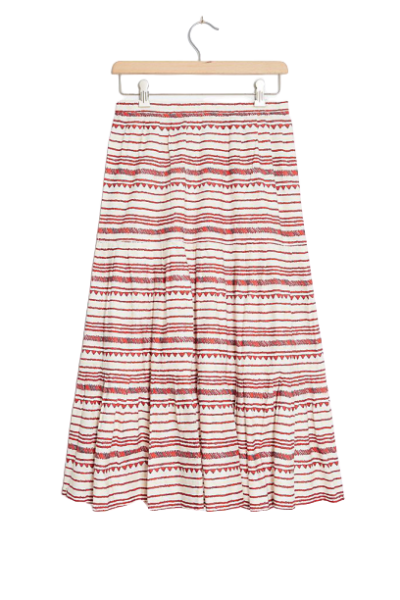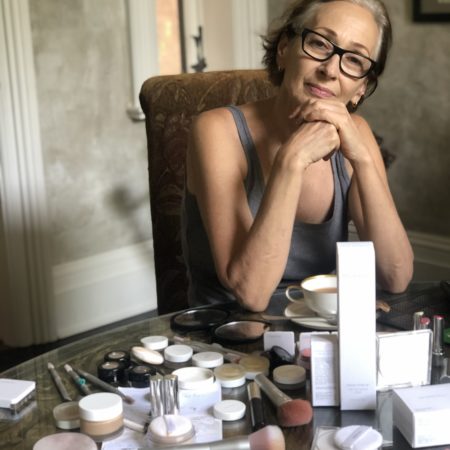Most know Tracy Reese as the favorite fashion designer of former First Lady Michelle Obama, but those now-iconic print dresses are only a small blip in the Detroit native’s impressive, decades-long career. Growing up near famed Eight Mile and Woodward Avenue, her mother taught her to sew as part of a community of home sewers around the city. “We’d spend all our extra money on fabric,” remembers the now 56-year-old founder. “We were always in fabric stores buying patterns. My mom had pretty much a whole room full of fabric.”
Hobby met opportunity while Reese was in high school. After taking a class in fashion design, her teacher told her to apply to Parsons, which she did—receiving a merit scholarship. Taking a leap of faith, Reese started her first eponymous label during the mid-’80s, which “went belly-side up” after the Stock Market Crash of 1987. After a stint at Perry Ellis alongside former classmate Marc Jacobs (“where I got my ‘big company’ experience,” she says), Reese eventually went on to build a retail empire boasting ready-to-wear apparel, handbags, shoes, home goods, and accessories. “Parsons was a fantastic school, but there was zero focus on the business side of fashion,” she remembers. “The school has since created a master’s program in fashion management, but at the time, we just knew how to make clothes.”
Now, with two flagship stores, four separate labels (Tracy Reese, Plenty, Frock!, and Tracy Reese Black Label), and 20 years of dressing celebrity clients like Gabrielle Union and Sarah Jessica Parker under her belt, Reese is entering a new chapter that aims to address the industry’s detrimental effect on the environment. “[In fashion] you’re constantly creating product. I got sick of it all,” she admits. “It seemed very backward and not intuitive anymore.” With a recently-launched sustainable label, Hope for Flowers, which uses organic cotton and organic linen based in her hometown of Detroit, Reese wants her customers to ask themselves a few questions before they buy: “Does this spark joy? Is this something you need? Something you absolutely have to have?” Here, the designer looks back on her career with the wisdom of a woman who’s tackled it all.
What did you do before you started your own label?
I wanted to make clothing that was somewhat affordable—I wanted to be able to reach real customers. So right before I graduated from Parsons in the mid-’80s, I got a job at a contemporary company designed by French designer Martine Sitbon. It was sort of the dawn of the contemporary sector in women’s apparel, and our little company was cutting edge. It was a really good first job, but after three years my dad was like, “You need to do your own thing.” And I was like, “I do?” He planted to seed. A lot of friends had branched out, and they were launching their own brands.
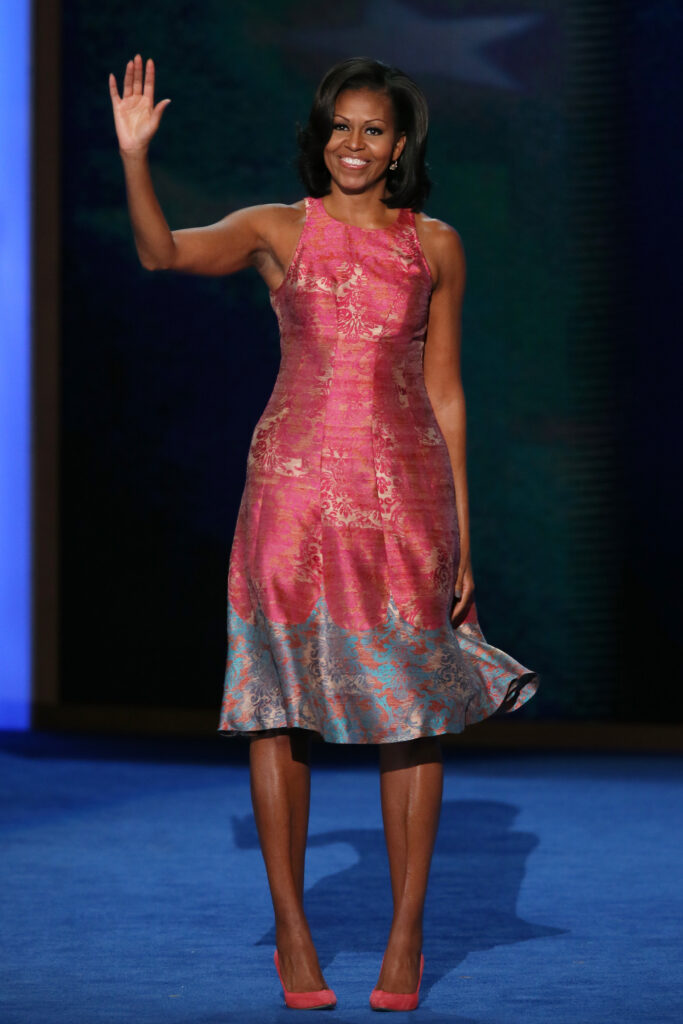
Why do you think it didn’t occur to you?
I’m not a risk-taker. The idea of financing and all that was just huge. But my dad is more of a risk-taker and was willing to give me the seed money. He kept me afloat for that whole first business; it was contemporary sportswear, I called it Tracy Reese. I was designing a full collection of dresses, blouses, pants, skirts. I wrote a business plan with the support of the Small Business Association, which was huge for me, too. The first business went belly-side up in 1988 during the financial crisis. I was at the point where I could have got additional backing, industry backing, but everything just crashed. There was no money.
I graduated from Parsons with Marc Jacobs; we had been bosom buddies for years and he was just about to go to Perry Ellis. He offered me a job designing the portfolio collection, which is where I got my “big company” experience. I was there for about 18 months and eventually became the head of the Women’s Portfolio working on shoes and coats. Then I had an opportunity to go to a brand called Magaschoni. I was there for about five years and they put my name on the label—Tracy Reese for Magaschoni—and that’s when I started having runway shows. It was another phase of my education, a sort of growing up period. When I left Magaschoni I decided I wanted to strike out again. I no longer wanted to work for someone else. I know a lot of designers hit this stage; they don’t want their work to be picked apart or watered down by “the suits” who are not always that in touch with the actual consumer. You eventually trust your vision and you want to be able to express it to the fullest. I started again in 1996. My dad supported me again in my next effort, and I also became a consultant for some big brands like Jones New York and Liz Claiborne to pay the rent, buy my sample fabric, and pay the factory: all the things we have to pay for upfront in our industry.
How much did it take to get going? How much did your dad kick in?
Traditionally in the fashion industry, you are pretty much nine months out of pocket before you get any receivables, so you have to be able to pay all your personal and production expenses, development expenses, and photoshoots for a minimum of nine months before you get a dime back. You need a good year’s worth of funding. My dad started me off with a chunk and sent me money pretty much every month to keep going. The money was a gift; he would never let me pay him back. I think he was passionate about me having the type of opportunity he never did.
When I started the business a second time I was busy consulting. I knew I had to keep a roof over my head, have money to buy materials. I would work in their offices during the day and in the evenings, I would go to a studio space I shared with another young designer to work on my samples and cut production. This was before we had computers on our desks; I would hand-tally my orders, write out all my invoices, and kept it going for another 18 months or so. I had [sales] representation and a really good showroom, a space where buyers could come to see my designs displayed. We were selling to Barneys, Saks, and Bergdorf’s—a lot of really good stores—but it was still small.
You eventually took on business partners. How did that come about?
I had the same accountant and lawyer as my future business partners which is how we crossed paths. They had a 3PL [third party logistics] warehouse that did all the back-end work of shipping and receiving, which was attractive to me; I was doing all my own and it was a haul. One of them also had a family manufacturing business out of India. They had factories in Delhi, Mumbai, and Bangalore. We decided to form an alliance and we started TR Designs together in 1997. There were two of them and one of me, so I ended up with 30 percent equity, and they split the 70 percent. I was the talent, and they were the finance.
Taking on a business partner is like a marriage; you have to be in it for the long-term if you expect to achieve success.
The opportunity to go to India, to be inspired by that amazing culture, and really work with artisans there to create embellishments—that was huge. It was really an eye-opening experience in so many ways; I got into the markets and culture and saw all this amazing craft. Every region has a different specialty; the textiles were off the chain. We decided to start the second brand, called Plenty, which was very Indian-inspired for the first five or six years. It was the beginning of a trend that just hung on in contemporary for quite some time. That line burst out of the gates, we were in every good store in the States; it really played to the zeitgeist of the moment. With Tracy Reese, we were able to expand our reach and solidify our supply chain. We started to hit a stride and the business grew organically for the first 10 years of what was a two-decade partnership. The business reached about $23 million wholesale by 2007. We were able to branch out into some licenses. We had shoes, handbags, belts, and homewares with soft home goods like bedding and bath. It was a natural progression. We also had a Japanese distributor, so we had a store in Tokyo as well as downtown in Manhattan. We launched e-commerce. The list goes on and on. We were playing the Contemporary Brand playbook.
What was it like to suddenly join forces with outside partners?
Taking on a partner is like a marriage; you are working that closely together, you have to be in it for the long-term if you expect to achieve success. There’s a lot of compromises involved. You have a lot at stake, but a lot you can build together if you have a shared vision. But what attracted me the most to my partners is that they were kind people. In our industry, that’s not a given. They didn’t come with expertise in brand-building or women’s clothing. They came with a lot of assets in terms of production in India and the 3PL [third party logistics] warehouse in New Jersey; the shipping and the logistical parts were where their strengths lay. The rest of it they had to learn because they were more affiliated with importing and lower-priced merchandise—they had to learn about making a better product in terms of quality.
For all of us, one of the greatest learning experiences we had was having a Japanese distributor, because if you are shaky on quality, it’s just not going to wash. It was a huge test for us because production out of India at the time was not very consistent—not consistent with deliveries, not consistent with quality. We had to really look deep into our supply chain and make some huge decisions, change a lot of things to bring the quality of production up to the standard of where we needed to be for Japan. We were also selling a lot in Europe. When you look at the price difference of doing international retail, that product really has to stand up. A dress that was $400 here, it’s 400 pounds in the UK. That translated to a lot more money. It was very similar to Japan because the distributor had a markup and then they had all kinds of import costs and their whole overhead. So the cost of the clothing in Japan was almost twice as much as what it was here in the U.S. We really placed our focus on being quality-conscious, making sure there was a lot of value in every item for both collections.
Shop Hope for Flowers by Tracy Reese
What have you learned about supply chains? What would you want new founders to think about?
At the end of the day, having direct relationships with your suppliers is important. Work directly with factories and cut out the agents and the middlemen. If you are working through a middleman and they are taking a cut, then the factory is being paid less. It just adds a layer of cost.
It’s so funny. We always used a lot of European textiles and worked with agents in New York. The agent would almost slow down the process. To call an agent, ask a question, have them ask the factory, get the answer back from the mill, and then contact you, it was just too slow. We would always end up corresponding directly with the mill, even though there was an agent in place. That’s how you build relationships. It’s critical to know your suppliers personally as much as you can—to be able to walk into a factory and understand how they are treating their workers, if they have heat in the winter, if they are working normal or crazy hours, if they have weekends off. You have to see it for yourself to really know who you are working with. It’s our responsibility to look further and have a real understanding of that. You want that trust, to know and understand how they are treating their workforce.
The first time I was exposed to your work was when Michelle Obama wore Tracy Reese as First Lady. What was it like to have her wear your clothes?
More amazing than you can imagine [laughs]. It was an incredible blessing. We kind of basked in that sunshine for eight years. Every now and then, we’d get a special request, but more often than not, she’d just pick things out of lookbooks. She would wear production like everyone else, and I think that was part of the beauty of it. We weren’t really structured to make custom anything; all of our production was offshore, and I didn’t have a sample room. We didn’t have that kind of structure. Even with any celebrity dressing we did, they were wearing samples or stock, because we didn’t custom make things for anyone.
I want to ask you about navigating the recession in 2008. I know some brands made unsustainable changes to survive.
There definitely was a downturn. I remember 2008 being rough. We had a record year leading into 2008, we reached a record high in sales. Things softened up after that. There were challenges and knowing the environment, we definitely tightened our belts. We focused more on waste. We had a lot of wasteful practices—just simple stuff, like sending a FedEx package to China every day. We definitely had to lay off some people; I think less than 10 percent, but we had to start working smarter. A lot of times companies forget to examine that, especially when business is good. It’s like, are you wasting a lot of paper? Are we using too many color cartridges in the copier? Why is our credit still $40,000 a month? We opened it up to the company in each department to make suggestions about ways we could trim the fat and stop wasting. What was happening with our leftover materials? Factories were supposed to be “killing the goods,” meaning if you complete the order and still have two bolts [of fabric] left, you have to let us know and we’ll tell you how to cut it. But I don’t think there was a lot of oversight from production, because when I went to China, I’d go into the factory and see a whole stockroom full of our own goods. We could have killed the goods and sold them as garments, and it would have had more value than having fabric sitting in their stores.
It’s critical to know your suppliers personally...to be able to walk into a factory and understand how they are treating their workers.
In the industry, 2012 was another moment where a lot of specialty stores closed and had a lot of credit issues. I remember it had something to do with financial markets, and it was a pervasive thing. We had to kind of go back to the boards and say, “Okay, how can we save? How can we work smarter?” That’s a question that every business should always be asking. Having the whole team really look at that together, and letting employees make suggestions and take ownership of decreasing waste, is really important.
You stopped showing at New York Fashion Week around 2018. Is that right?
Yeah. It was September of 20… it all blends together. Like, wait a minute, let me think [laughs].
I can only imagine! That’s part of the problem, right? There’s so much expectation to constantly show?
It’s an incredible amount of work to prepare a fashion show. It takes a lot of energy and a lot of resources, and you’re caught up in this cycle: if you don’t show, people will think you’re out of business or doing poorly. There are benefits from a marketing perspective, but in many ways, it takes your eye off the ball. There’s no way you can compete with a behemoth, brands that are investing millions into runway—and magazine editors are definitely swayed by these huge presentations, the gifting, the excess, the big production, the best models, celebrities in the front row and all that. Financially it’s not possible for more than the top five percent of brands to be able to afford it. So it’s like, are you designing for editors or your customer? I always insisted that everything we sent down that runway would be in our showroom—I didn’t like to design “showpieces” that we weren’t intending to sell. That didn’t make sense to me. Some people have a runway collection and a showroom collection. A) that’s a whole lot of samples and B) what’s the point?
The [NYFW] calendar got so big and heavy; there were three shows in every time slot, all this politicking and drama about protecting that time slot, getting the models you wanted. It became kind of ridiculous and so commercialized. The purpose got really distorted. And then after direct-to-consumer entered the field, the customer got bored with it. They think, “All of this happened and I can’t even get it for six months?” This is a moment where things are being deeply rethought. We’ll see what comes out of it. I know the CFDA is working on a whole recommendation and report on how to make fashion more sustainable, less wasteful, and that’s a part of it. But each brand needs to do soul-searching and really understand why they are showing, and how they want to move forward.

When did you start really sensing you needed to shift your priorities?
About three years ago, the business started to contract. We reached a point where there was an expectation in the market that we should be doing more to support our own brand, like advertising and marketing. We should have graduated to another level, but in a lot of ways, we were still operating like a startup. I was also starting to learn more about sustainability and the damage our industry does to the planet and to the people in the supply chain. It’s been a real “come to Jesus” time for fashion to reflect on what we are doing and why. For anyone who has worked in the industry for a long time and has had a certain amount of success, the reason why you are working changes—you have other concerns. You have employees you are responsible for. You have business extensions, the list goes on. I realized we were working like crazy people, always developing more and more product. It’s interesting how technology, too, has changed product development. In a lot of ways, it’s made it easier. Everything is in photoshop—no one has to have an imagination anymore. You can see everything from conception, you can develop more, especially when you are working with vertical producers overseas. The lines are bigger. There are more collections. The stores want more deliveries. You go from maybe doing seven deliveries a year to more than 10. We needed that constant cash flow. We needed to have something on the books every month to support overhead. So you’re just constantly creating product. You are not looking to the left or the right. It takes some of the joy and spontaneity out of it—okay, not a little bit, a lot, because people are looking at last year to predict next year instead of following your gut and doing what moves you.
I got sick of it all. It seemed very backward, and not intuitive anymore. Not spontaneous. I’m not even naturally spontaneous, but in terms of design and creating products, there has to be a spontaneity to it. There has to be a visceral reaction, following the gut instead of data. Everyone has been hoodwinked into thinking data is the answer, but it’s not. It’s more like, “Does this spark joy? Is this something you need? Something you absolutely have to have?” You cannot read that in data.
How do you move a traditionally-operated brand to be a more sustainable one?
My partners were not thinking along the same lines as I was. They came to me one day to say they really wanted to start making products for Costco. I was like, “Costco? Why would I ever want to make products for Costco?” Basically, Costco wanted us to produce tens of thousands of units of polyester blouses. I’m like, “What? Why? Why would we want to do that?” First of all, my perception was that Costco would bully the hell out of any manufacturer or factory that you’re working in. You are working with goods you wouldn’t want touching your own body. Your margins are almost nonexistent, and the relationships with these big-box companies are brutal. This is not our core competency; we don’t know how to do it, and it’s not a good thing to do. They had other friends in the industry at different levels who were telling them they were missing the boat by not jumping on that bandwagon. It was one of the biggest arguments I think we ever had, and we’d had a smooth relationship for 20 years. It was an “a-ha” moment on both sides where we realized… maybe this relationship is winding down. I’ll put it that way [laughs]. Long story short, we parted ways.
What does it look like to part ways with a business partner?
It looks like a divorce [laughs].
Oh, no. You mean, there’s no easy way?
If you have a really strong prenup, that could be the easier way! But no. It’s like a divorce. Everyone has their own perspective on what the relationship meant and where the spoils should go, and that’s fair. I don’t know if I know anyone who has parted from a substantial business and walked away unscarred. We tried to keep it as amicable as possible, but a little ugliness comes out here and there. At the end of the day, it depends on you as a person—what kind of energy you want to have out there. For me, it’s painful to have bad energy in the universe and I prefer to try to settle things. Even though we disagreed over a lot by the end, [my business partners] are still people I love and respect. But fairness is important. Especially as a woman designer, it’s easy for people to take advantage of you—not even maliciously, or even think they are. You really have to be a strong advocate for yourself.
What happened to the brand after you separated?
In 2018 I was accepted into the CFDA Lexus Fashion Initiative—they call it a virtual residency in sustainability. It was a nine-month program. During that time, I learned so much about different ways to approach design more ethically, responsibly, and producing more sustainable product. That was so incredibly helpful because breaking the habits of a career is not easy. You have to look at your whole supply chain and start the process from a different perspective. It’s been a blessing to have the opportunity to fall in love with what I do again, to take my time, slow things down and really think about what I’m designing, and how it affects everybody who lays a hand on the process of producing the clothing.
"As a woman, it’s easy for people to take advantage of you...you really have to be a strong advocate for yourself."
Luckily, I developed a strong relationship with Anthropologie over the years; they were one of our biggest partners at TR, with Tracy Reese and Plenty. I told them what I was planning to do, and they were super-supportive. For the first three seasons, they were my exclusive retail partner for the new brand, Hope for Flowers. Also, through the Lexus challenge, I was able to do some production in Flint, Michigan.
Part of my business plan going forward is to bring a percentage of my production back to the U.S. I’m on a board here called ISAIC, the Industrial Sewing and Innovation Center. Before the pandemic, we opened a factory in Midtown Detroit with a lot of help from Carharrt, and we had to pivot the factory to produce PPE on the fly. We are literally sewing hospital gowns and working with small manufacturers in southeast Michigan to meet these orders for the state of Michigan and the Detroit Medical Center. I’ve been on that board for two and a half years, and it’s been such a learning experience. I’ve met so many wonderful people. Just when things were sort of breaking down on the TR Design side, and our partnership was ending, I purchased a house here in Detroit. I was always coming home to see family for the holidays and I saw how much change was happening; I wanted to be a part of it. Being here on a regular basis, I’ve also seen a lot of inequity. We talk about the revitalization of the city, but a lot of the opportunity—the grants and the support—is not going to Detroiters. It is going to people who know how to write a grant application. I want to be a part of bringing some equity to this revitalization. I want to help Detroit Public School kids be exposed to the arts. Obviously, my role in that is super-tiny, but I think every little bit helps. There’s a lot going on here.
What would you suggest new founders focus on during this time of the pandemic?
It’s a weird time. I think it opened a lot of eyes to the fact we don’t make anything here anymore. When things go down, we’re out of luck. We need a domestic supply chain, we need to allocate a certain percentage of our purchases to domestic suppliers. I think we’re going to hear more about that in different sectors.
For new founders and small businesses, for this time, it’s a hibernation period for a lot of us. We don’t really know when the market is going to open back up. We don’t know when wallets are going to open back up. We don’t know when people are going to be able to go out and shop again, or if they’ll have the disposable income to shop with. This is a time for introspection and planning, to really look at how you’re doing business, what kind of overhead you have, and figure out ways to get leaner and meaner. It’s hard to give a lot of advice because there’s so much that’s unknown. We’ve got time to think about it. This is an opportunity for a lot of companies to make big decisions about how they’re going to go forward, hopefully in a more ethical and sustainable way.
*This interview has been edited for length and clarity
Jenna Birch is a freelance journalist and author of The Love Gap. Her work has been published in The Washington Post, Vogue, Harper’s Bazaar, ELLE, InStyle, Fortune, Man Repeller, and more. Read more of her work here.
